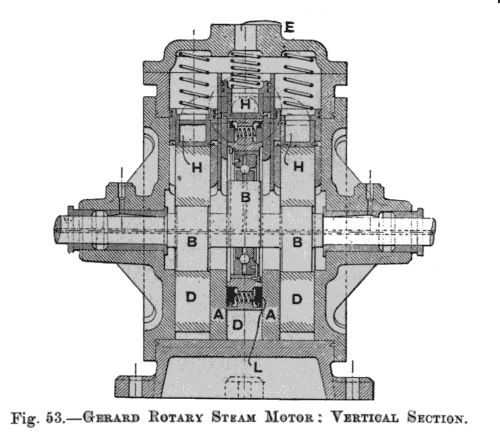Updated: 4 Aug 2007






Rotary Steam Engines: Page 8. |
Updated: 4 Aug 2007 |
The possibility of driving automobiles with rotary engines was not lost on the motoring pioneers. In the early years of the 20th century, it was far from clear that the IC engine was going to be the dominant technology. There were many steam cars, not to mention steam bicycles and steam tricycles, and the Land Speed Record was held by steam cars twice. (mind you, the LSR was initially held by an electric car, and a hundred years later we have still not found a way to make that a practical means of transport)
THE GERARD ROTARY ENGINE: 18??
AUTOMOBILES AND ROTARY ENGINES.
Almost all steam road vehicles were driven by reciprocating engines; one exception being produced by M Gerard...
 | Left: Basic operation of the Gerard rotary engine.
This engine was used by the Compagnie General des Automobiles in a steam omnibus, who described it as an epicycloidal motor, systeme A Gerard.
Fig 50 at left shows steam admission. The cap H on top of disc D is angled to open the port in its centre, and allow steam in from the top inlet E.
Fig 51 shows the expansion period. H has tilted so as to close its admission port.
|
 | Left: A detailed view of the of the internal construction of the Gerard rotary.
This shows the beginning of the exhaust phase, with disc D about to uncover exhaust port F.
B is eccentrically keyed onto the central shaft, and the disc D rolls around this on ball bearings. R,R are springs that press seals against the ends of the cylinder.
It was claimed the engine could be run at any speed between 60 and 24,000 rpm. The lower speeds were attractive as they eliminated the need for reduction gearing to match it to road-wheel speeds. Consumption of steam at the first trials was claimed to be less than 55 pounds per horsepower-hour; a rate that is markedly higher than that claimed for the Hult engine.
|
 | Left: Transverse section of the Gerard rotary engine.
A,A are partitions between the three volumes containing the discs D.
Note the ball-cage around the middle eccentric B, and the sealing pieces L pressed outwards by springs.
|
THE ARBEL-TIHON ROTARY ENGINE: 1898
 | Left: The Arbel-Tihon reversible rotary engine was exhibited at the Tuileries, Paris in 1898.
|
 | Left: The Arbel-Tihon rotary engine as depicted by the French journal Nature on 17 September, 1898.
|
De Lambilly exhibited a reversible rotary engine at the Tuileries in 1899. No other details currently available.
Bibliography: The Automobile: Its Construction & Management, by Gérard Lavergne 1st edn, 1902.

   
|